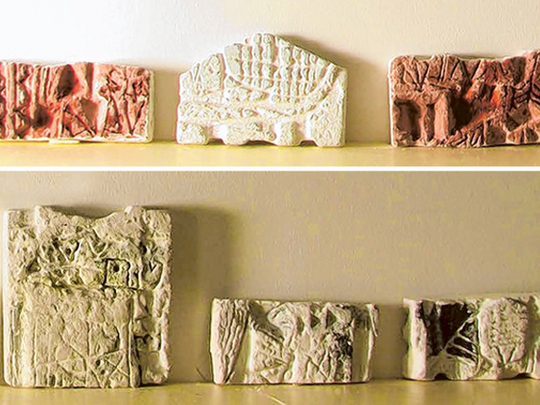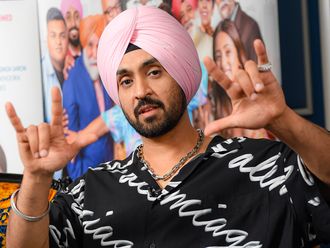
The concept behind “Crossings”, a series of three exhibitions curated by Egyptian artist and curator Mohammad Abu Al Naga, is to explore the role of contemporary art in bridging diverse cultures in an increasingly globalised world. While the two earlier shows facilitated a dialogue between artists from Africa and the Middle East, the final exhibition in the series features Medhat Shafik, an artist who has assimilated African, Arab and European influences into his work. Shafik was born in Egypt in 1956, studied art in Milan and has lived and worked in Italy since 1976. His show, “Archaeology of the Spirit”, presents his unique perspective of the social, political, cultural and emotional impact of globalisation on individuals and on society.
Shafik’s artworks look like ancient artefacts unearthed from archaeological digs. They are covered with letters and symbols taken from various ancient cultures and civilizations. But they come, essentially, from his excavation of his own subconscious. The pieces express his sense of rootlessness, alienation and confusion in a new and changing world, as well as the excitement of having the freedom to discover new cultures and new ways of thinking. But they go beyond his personal story, to tell the story of all mankind.
“This show is about exploring the many strata and sediments of my emotional life to tell my little story, which is a part of the big story, not only of Egyptians or Arabs, but of the whole world. The sediments of the Nile exist in my mind, body and heart; but taking this metaphor further, just as the Nile flows across Africa into the Mediterranean, my identity and point of view have also been shaped by my experiences of other places and cultures,” Shafik says.
The artist has used an interesting process to create his work. He carved the letters and symbols into pieces of old wood. He then pressed layers of wet cotton paper into this mould by stamping on it with his feet. The artworks are decorated with fragments of colourful fabrics, touches of colour from natural materials such as coffee and spices, splashes of gold paint and strips of bark that symbolise life, love, the light that exists within us and the spirituality that brings balance in our lives. In many artworks, pieces of the wooden moulds appear alongside the cotton positives made from them.
References to ancient Egypt in his work express the artist’s nostalgia and his concern about the present situation in the country. “Sometimes you can feel like a stranger in your own country. But your home is in your heart and mind. And through the brightness and gold in my work I want to say that we must store this precious emotion and hold on to who we are and use this as an anchor and as a positive energy to work towards a better future,” he says.
“In today’s globalised world, things are so fluid and changing so fast that we are disoriented and have no time to reflect on what is happening around us. We need a compass to reorient ourselves and find our place in this ever-evolving scenario. I believe that as an artist, it is my responsibility to stop, take a deep breath and look back at the past and ahead at the future to search for the right path and a new vision for humanity. I have tried to distance myself from the present moment and to metaphorically glide through human history searching for those forgotten traces of beauty, goodness, happiness, spirituality and hope that define our identity and will help to restore the balance and magic in our lives,” he adds.
Jyoti Kalsi is an arts enthusiast based in Dubai.
“Archaeology of the Spirit” will run at The Mojo Gallery until April 30.
Dealing with PTSD
In his latest show, “PTSD”, New York-based Iranian artist Shahpour Pouyan continues his investigation of the forms and structures of power and hegemony, through a series of ceramic works inspired by ancient monuments and modern weaponry. The title of the show, which is curated by Murtaza Vali, refers to the anxiety caused by the destructive nature of human beings and the fact that working with ceramics is a commonly prescribed therapy for those struggling with Post Traumatic Stress Disorder (PTSD).
The exhibition features four groups of objects, each presented on a table. The first group, “Still Life”, is a three-dimensional recreation of a French army photograph of seized German artillery shells, taken during the First World War. The second group, “Unthinkable Thought”, features miniature replicas of domed structures from different places and eras, including the Pantheon in Rome, a 5th-century Persian palace, a mosque in Cairo, and a gigantic structure designed by Hitler’s architects but never built.
On the next table is presented a row of hemispherical objects ranging in size from 30 centimetres to a few millimetres. This work, titled “Tzar Trauma”, represents various explosive devices and nuclear weapons such as “Bunker Busters” and the nuclear bomb that destroyed Hiroshima, commenting on the growing capacity of nuclear destruction through the 20th century. An upside-down drawing of Peak Damavand, Iran’s tallest mountain, placed alongside this group warns of the dangers of Iran’s nuclear ambitions. The final group, “Failed Object”, features various ambiguous objects that blur the line between organic and inorganic, body and machine, masculine and feminine and suggest containment, nurturing, and fertility.
Pouyan’s ceramic models of weapons and monuments draw attention to the hunger of human beings for power and their use of science and technology for destruction and domination, highlighting the phallic shapes as references to the patriarchal structure of Middle Eastern society. But his “failed objects” offer the hope of creation and regeneration.
“PTSD” will run at Lawrie Shabibi gallery until April 22.












